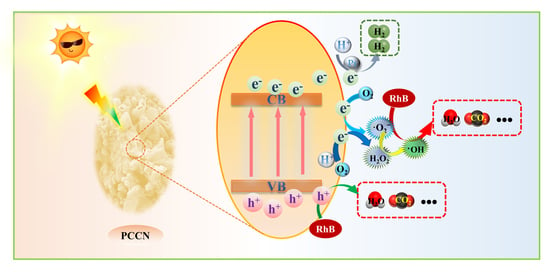A Novel Synthetic 3D Interconnected Porous Carbon-Rich Graphitic Carbon Nitride for Boosting Visible Light Photocatalytic Hydrogen Production and Dye Contaminant Degradation
Abstract
:1. Introduction
2. Results and Discussion
2.1. Morphologies and Structures
2.2. Optical and Electrochemical Performance
2.3. Photocatalytic Capacity for H2 Production and RhB Degradation
2.4. Mechanism of Enhanced Photocatalytic Activity
3. Materials and Methods
3.1. Materials and Reagents
3.2. Fabrication of the Catalysts
3.2.1. Synthesis of BCN
3.2.2. Preparation of PCN
3.2.3. Preparation of PCCN
3.3. Characterization Measurements
3.4. Photocatalytic Measurements
4. Conclusions
Supplementary Materials
Author Contributions
Funding
Data Availability Statement
Conflicts of Interest
References
- Shao, Y.; Hao, X.; Lu, S.; Jin, Z. Molten salt-assisted synthesis of nitrogen-vacancy crystalline graphitic carbon nitride with tunable band structures for efficient photocatalytic overall water splitting. Chem. Eng. J. 2023, 454, 140123. [Google Scholar] [CrossRef]
- Zhao, H.; Jiang, Z.; Xiao, K.; Sun, H.; Chan, H.S.; Tsang, T.H.; Yang, S.; Wong, P.K. Photo-assisted separation of noble-metal-free oxidation and reduction cocatalysts for graphitic carbon nitride nanosheets with efficient photocatalytic hydrogen evolution. Appl. Catal. B Environ. 2021, 280, 119456. [Google Scholar] [CrossRef]
- Thangamuthu, M.; Vankayala, K.; Xiong, L.; Conroy, S.; Zhang, X.; Tang, J. Tungsten oxide-based Z-scheme for visible light-driven hydrogen production from water splitting. ACS Catal. 2023, 13, 9113–9124. [Google Scholar] [CrossRef]
- Tang, R.; Gong, D.; Zhou, Y.; Deng, Y.; Feng, C.; Xiong, S.; Huang, Y.; Peng, G.; Li, L. Unique g-C3N4/PDI-g-C3N4 homojunction with synergistic piezo-photocatalytic effect for aquatic contaminant control and H2O2 generation under visible light. Appl. Catal. B Environ. 2022, 303, 120929. [Google Scholar] [CrossRef]
- Carey, J.H.; Lawrence, J.; Tosine, H.M. Photodechlorination of PCB’s in the presence of titanium dioxide in aqueous sus-pensions. Bull. Environ. Contam. Toxicol. 1976, 16, 697–701. [Google Scholar] [CrossRef] [PubMed]
- Wong, K.J.; Foo, J.J.; Siang, T.J.; Ong, W. Shining light on carbon aerogel photocatalysts: Unlocking the potentials in the quest for revolutionizing solar-to-chemical conversion and environmental remediation. Adv. Funct. Mater. 2023, e2306014. [Google Scholar] [CrossRef]
- Ai, M.; Pan, L.; Shi, C.; Huang, Z.-F.; Zhang, X.; Mi, W.; Zou, J.-J. Spin selection in atomic-level chiral metal oxide for photocatalysis. Nat. Commun. 2023, 14, 4562. [Google Scholar] [CrossRef]
- Shi, Y.; Zhao, Q.; Li, J.; Gao, G.; Zhi, J. Onion-liked carbon-embedded graphitic carbon nitride for enhanced photocatalytic hydrogen evolution and dye degradation. Appl. Catal. B Environ. 2022, 308, 121216. [Google Scholar] [CrossRef]
- Wang, L.; Lian, R.; Zhang, Y.; Ma, X.; Huang, J.; She, H.; Liu, C.; Wang, Q. Rational preparation of cocoon-like g-C3N4/COF hybrids: Accelerated intramolecular charge delivery for photocatalytic hydrogen evolution. Appl. Catal. B Environ. 2022, 315, 121568. [Google Scholar] [CrossRef]
- Yang, M.; Wang, P.; Li, Y.; Tang, S.; Lin, X.; Zhang, H.; Zhu, Z.; Chen, F. Graphene aerogel-based NiAl-LDH/g-C3N4 with ultratight sheet-sheet heterojunction for excellent visible-light photocatalytic activity of CO2 reduction. Appl. Catal. B Environ. 2022, 306, 121065. [Google Scholar] [CrossRef]
- Liu, M.; Ning, Y.; Ren, M.; Fu, X.; Cui, X.; Hou, D.; Wang, Z.; Cui, J.; Lin, A. Internal electric field-modulated charge migration behavior in MoS(2)/MIL-53(Fe) S-scheme heterojunction for boosting visible-light-driven photocatalytic chlorinated antibiotics degradation. Small 2023, e2303876. [Google Scholar] [CrossRef] [PubMed]
- Yu, Y.; Huang, H. Coupled adsorption and photocatalysis of g-C3N4 based composites: Material synthesis, mechanism, and environmental applications. Chem. Eng. J. 2023, 453, 139755. [Google Scholar] [CrossRef]
- Li, H.; Li, R.; Liu, G.; Zhai, M.; Yu, J. Noble-metal-free single- and dual-atom catalysts for artificial photosynthesis. Adv. Mater. 2023, e2301307. [Google Scholar] [CrossRef] [PubMed]
- Pan, X.; Kong, F.; Xing, M. Spatial separation of photo-generated carriers in g-C3N4/MnO2/Pt with enhanced H2 evolution and organic pollutant control. Res. Chem. Intermed. 2022, 48, 2837–2855. [Google Scholar] [CrossRef]
- Sun, J.; Yang, S.; Liang, Z.; Liu, X.; Qiu, P.; Cui, H.; Tian, J. Two-dimensional/one-dimensional molybdenum sulfide (MoS2) nanoflake/graphitic carbon nitride (g-C3N4) hollow nanotube photocatalyst for enhanced photocatalytic hydrogen production activity. J. Colloid Interf. Sci. 2020, 567, 300–307. [Google Scholar] [CrossRef] [PubMed]
- Marchi, M.; Raciti, E.; Gali, S.M.; Piccirilli, F.; Vondracek, H.; Actis, A.; Salvadori, E.; Rosso, C.; Criado, A.; D’Agostino, C.; et al. Carbon vacancies steer the activity in dual Ni carbon nitride photocatalysis. Adv. Sci. 2023, 10, e2303781. [Google Scholar] [CrossRef]
- Xie, K.; Fang, J.; Li, L.; Deng, J.; Liang, Z. Enhancement of the Photodegradation Activity of methylene blue by the low-temperature regulation of oxide-rich graphitic carbon nitride. ChemistrySelect 2021, 6, 11407–11416. [Google Scholar] [CrossRef]
- Lei, Z.; Cao, X.; Fan, J.; Hu, X.; Hu, J.; Li, N.; Sun, T.; Liu, E. Efficient photocatalytic H2 generation over In2.77S4/NiS2/g-C3N4 S-scheme heterojunction using NiS2 as electron-bridge. Chem. Eng. J. 2023, 457, 141249. [Google Scholar] [CrossRef]
- Yuan, J.; Tian, N.; Zhu, Z.; Yu, W.; Li, M.; Zhang, Y.; Huang, H. P, K doped crystalline g-C3N4 grafted with cyano groups for efficient visible-light-driven H2O2 evolution. Chem. Eng. J. 2023, 467, 143379. [Google Scholar] [CrossRef]
- Liu, D.; Li, C.; Ni, T.; Gao, R.; Ge, J.; Zhang, F.; Wu, W.; Li, J.; Zhao, Q. 3D interconnected porous g-C3N4 hybridized with Fe2O3 quantum dots for enhanced photo-Fenton performance. Appl. Surf. Sci. 2021, 555, 149677. [Google Scholar] [CrossRef]
- Sun, B.; Lu, N.; Su, Y.; Yu, H.; Meng, X.; Gao, Z. Decoration of TiO2 nanotube arrays by graphitic-C3N4 quantum dots with improved photoelectrocatalytic performance. Appl. Surf. Sci. 2017, 394, 479–487. [Google Scholar] [CrossRef]
- Liu, Z.; Liu, Y.; Sun, X.; Ji, H.; Liu, W.; Cai, Z. Construction of Z-scheme Ag/AgVO3/carbon-rich g-C3N4 heterojunction for enhanced photocatalytic degradation of sulfamethiadiazole: DFT calculation and mechanism study. Chem. Eng. J. 2022, 433, 133604. [Google Scholar] [CrossRef]
- Jiang, J.; Xiong, Z.; Wang, H.; Liao, G.; Bai, S.; Zou, J.; Wu, P.; Zhang, P.; Li, X. Sulfur-doped g-C3N4/g-C3N4 isotype step-scheme heterojunction for photocatalytic H2 evolution. J. Mater. Sci. Technol. 2022, 118, 15–24. [Google Scholar] [CrossRef]
- Huang, J.; Li, D.; Li, R.; Zhang, Q.; Chen, T.; Liu, H.; Liu, Y.; Lv, W.; Liu, G. An efficient metal-free phosphorus and oxygen co-doped g-C3N4 photocatalyst with enhanced visible light photocatalytic activity for the degradation of fluoroquinolone antibiotics. Chem. Eng. J. 2019, 374, 242–253. [Google Scholar] [CrossRef]
- Gao, Y.; Zhu, Y.; Lyu, L.; Zeng, Q.; Xing, X.; Hu, C. Electronic structure modulation of graphitic carbon nitride by oxygen doping for enhanced catalytic degradation of organic pollutants through peroxymonosulfate activation. Environ. Sci. Technol. 2018, 52, 14371–14380. [Google Scholar] [CrossRef] [PubMed]
- Zhu, Y.P.; Ren, T.Z.; Yuan, Z.Y. Mesoporous Phosphorus-doped g-C3N4 nanostructured flowers with superior photocatalytic hydrogen evolution performance. ACS Appl. Mater. Inter. 2015, 7, 16850–16856. [Google Scholar] [CrossRef] [PubMed]
- Yu, G.; Gong, K.; Xing, C.; Hu, L.; Huang, H.; Gao, L.; Wang, D.; Li, X. Dual P-doped-site modified porous g-C3N4 achieves high dissociation and mobility efficiency for photocatalytic H2O2 production. Chem. Eng. J. 2023, 461, 142140. [Google Scholar] [CrossRef]
- Cui, Q.; Xu, J.; Wang, X.; Li, L.; Antonietti, M.; Shalom, M. Phenyl-modified carbon nitride quantum dots with distinct photoluminescence behavior. Angew. Chem. Int. Ed. Engl. 2016, 55, 3672–3676. [Google Scholar] [CrossRef] [PubMed]
- Zhao, Y.; Zhao, F.; Wang, X.; Xu, C.; Zhang, Z.; Shi, G.; Qu, L. Graphitic carbon nitride nanoribbons: Graphene-assisted formation and synergic function for highly efficient hydrogen evolution. Angew. Chem. Int. Ed. Engl. 2014, 53, 13934–13939. [Google Scholar] [CrossRef]
- Wang, X.; Zhang, X.; Wei, Y.; Gao, C.; Bao, J.; Zhang, N. In situ grown Co3O4 nanosheets in the interlayer space of g-C3N4 for efficient removal of Hg0 from flue gas. Fuel 2022, 324, 124660. [Google Scholar] [CrossRef]
- Liu, D.; Li, C.; Zhao, C.; Zhao, Q.; Niu, T.; Pan, L.; Xu, P.; Zhang, F.; Wu, W.; Ni, T. Facile synthesis of three-dimensional hollow porous carbon doped polymeric carbon nitride with highly efficient photocatalytic performance. Chem. Eng. J. 2022, 438, 135623. [Google Scholar] [CrossRef]
- Guo, Q.; Zhang, Y.; Zhang, H.S.; Liu, Y.; Zhao, Y.J.; Qiu, J.; Dong, G. 3D foam strutted graphene carbon nitride with highly stable optoelectronic properties. Adv. Funct. Mater. 2017, 27, 1703711. [Google Scholar] [CrossRef]
- Tian, N.; Zhang, Y.; Li, X.; Xiao, K.; Du, X.; Dong, F.; Waterhouse, G.I.N.; Zhang, T.; Huang, H. Precursor-reforming protocol to 3D mesoporous g-C3N4 established by ultrathin self-doped nanosheets for superior hydrogen evolution. Nano Energy 2017, 38, 72–81. [Google Scholar] [CrossRef]
- Chen, X.; Shi, R.; Chen, Q.; Zhang, Z.; Jiang, W.; Zhu, Y.; Zhang, T. Three-dimensional porous g-C3N4 for highly efficient photocatalytic overall water splitting. Nano Energy 2019, 59, 644–650. [Google Scholar] [CrossRef]
- Hu, S.; Ma, L.; You, J.; Li, F.; Fan, Z.; Lu, G.; Liu, D.; Gui, J. Enhanced visible light photocatalytic performance of g-C3N4 photocatalysts co-doped with iron and phosphorus. Appl. Surf. Sci. 2014, 311, 164–171. [Google Scholar] [CrossRef]
- Bhuvaneswari, K.; Palanisamy, G.; Pazhanivel, T.; Maiyalagan, T.; Bharathi, G. Photodegradation activity of nitrogen-rich graphitic carbon nitride intercalated ZnO\Mg-Al layered double hydroxide ternary nanocomposites on methylene blue dye. ChemistrySelect 2019, 4, 2982–2990. [Google Scholar] [CrossRef]
- Sun, L.; Wang, W.; Zhang, C.; Cheng, M.; Zhou, Y.; Yang, Y.; Luo, H.; Qin, D.; Huang, C.; Ouyang, Z. Multiple optimization strategies for improving photocatalytic performance of the h-BN/flower-ring g-C3N4 heterostructures: Morphology engineering and internal electric field effect. Chem. Eng. J. 2022, 446, 137027. [Google Scholar] [CrossRef]
- Qin, J.; Jiao, Y.; Liu, M.; Li, Y.; Wang, J. Heat treatment to prepare boron doped g-C3N4 nanodots/carbon-rich g-C3N4 nanosheets heterojunction with enhanced photocatalytic performance for water splitting hydrogen evolution. J. Alloy. Compd. 2022, 898, 162846. [Google Scholar] [CrossRef]
- Sheng, Y.; Wei, Z.; Miao, H.; Yao, W.; Li, H.; Zhu, Y. Enhanced organic pollutant photodegradation via adsorption/photocatalysis synergy using a 3D g-C3N4/TiO2 free-separation photocatalyst. Chem. Eng. J. 2019, 370, 287–294. [Google Scholar] [CrossRef]
- Luo, W.; Chen, X.; Wei, Z.; Liu, D.; Yao, W.; Zhu, Y. Three-dimensional network structure assembled by g-C3N4 nanorods for improving visible-light photocatalytic performance. Appl. Catal. B Environ. 2019, 255, 117761. [Google Scholar] [CrossRef]
- Cui, M.; Cui, K.; Liu, X.; Chen, X.; Guo, Z.; Chen, Y.; Li, C.X. Insights into the photocatalytic peroxymonosulfate activation over defective boron-doped carbon nitride for efficient pollutants degradation. J. Hazard. Mater. 2021, 418, 126338. [Google Scholar] [CrossRef]
- Zhan, H.; Zhou, Q.; Li, M.; Zhou, R.; Mao, Y.; Wang, P. Photocatalytic O2 activation and reactive oxygen species evolution by surface B-N bond for organic pollutants degradation. Appl. Catal. B Environ. 2022, 310, 121329. [Google Scholar] [CrossRef]
- Huang, Y.; Wang, Y.; Bi, Y.; Jin, J.; Ehsan, M.F.; Fu, M.; He, T. Preparation of 2D hydroxyl-rich carbon nitride nanosheets for photocatalytic reduction of CO2. RSC Adv. 2015, 5, 33254–33261. [Google Scholar] [CrossRef]
- Wang, K.; Shao, X.; Zhang, K.; Wang, J.; Wu, X.; Wang, H. 0D/3D Bi3TaO7/ZnIn2S4 heterojunction photocatalyst towards degradation of antibiotics coupled with simultaneous H2 evolution: In situ irradiated XPS investigation and S-scheme mechanism insight. Appl. Surf. Sci. 2022, 596, 153444. [Google Scholar] [CrossRef]
- Liu, W.; Li, Y.; Liu, F.; Jiang, W.; Zhang, D.; Liang, J. Visible-light-driven photocatalytic degradation of diclofenac by carbon quantum dots modified porous g-C3N4: Mechanisms, degradation pathway and DFT calculation. Water Res. 2019, 151, 8–19. [Google Scholar] [CrossRef] [PubMed]
- Zhao, C.; Sun, H.; Li, C.; Wang, M.; Wu, J.; Chen, M.; Jiang, S.; Niu, T.; Liu, D. Facile Synthesis of 3D Interconnected Porous g-C3N4/rGO Composite for Hydrogen Production and Dye Elimination. Catalysts 2023, 13, 1079. [Google Scholar] [CrossRef]
- Huang, D.; Sun, X.; Liu, Y.; Ji, H.; Liu, W.; Wang, C.-C.; Ma, W.; Cai, Z. A carbon-rich g-C3N4 with promoted charge separation for highly efficient photocatalytic degradation of amoxicillin. Chin. Chem. Lett. 2021, 32, 2787–2791. [Google Scholar] [CrossRef]
- Zhao, C.; Li, C.; Chen, M.; Niu, T.; Zhao, Q.; Ni, T.; Yan, D.; Wu, W.; Liu, D. Effective removal of antineoplastic doxorubicin by 0D Nb2O5 quantum dots embed 3D porous C-doped g-C3N4: Degradation mechanism, pathway and toxicity assessment. Appl. Surf. Sci. 2023, 612, 155861. [Google Scholar] [CrossRef]
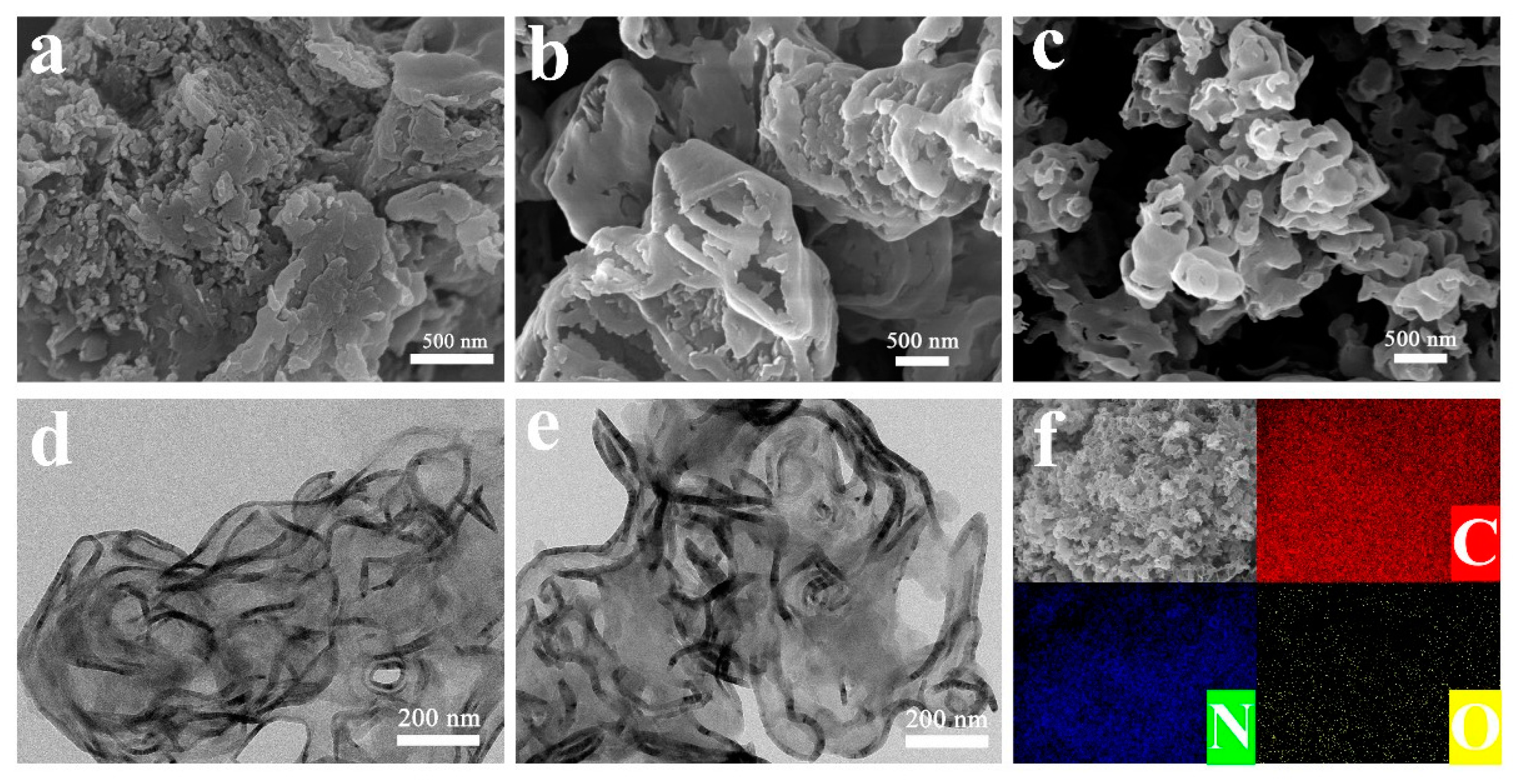

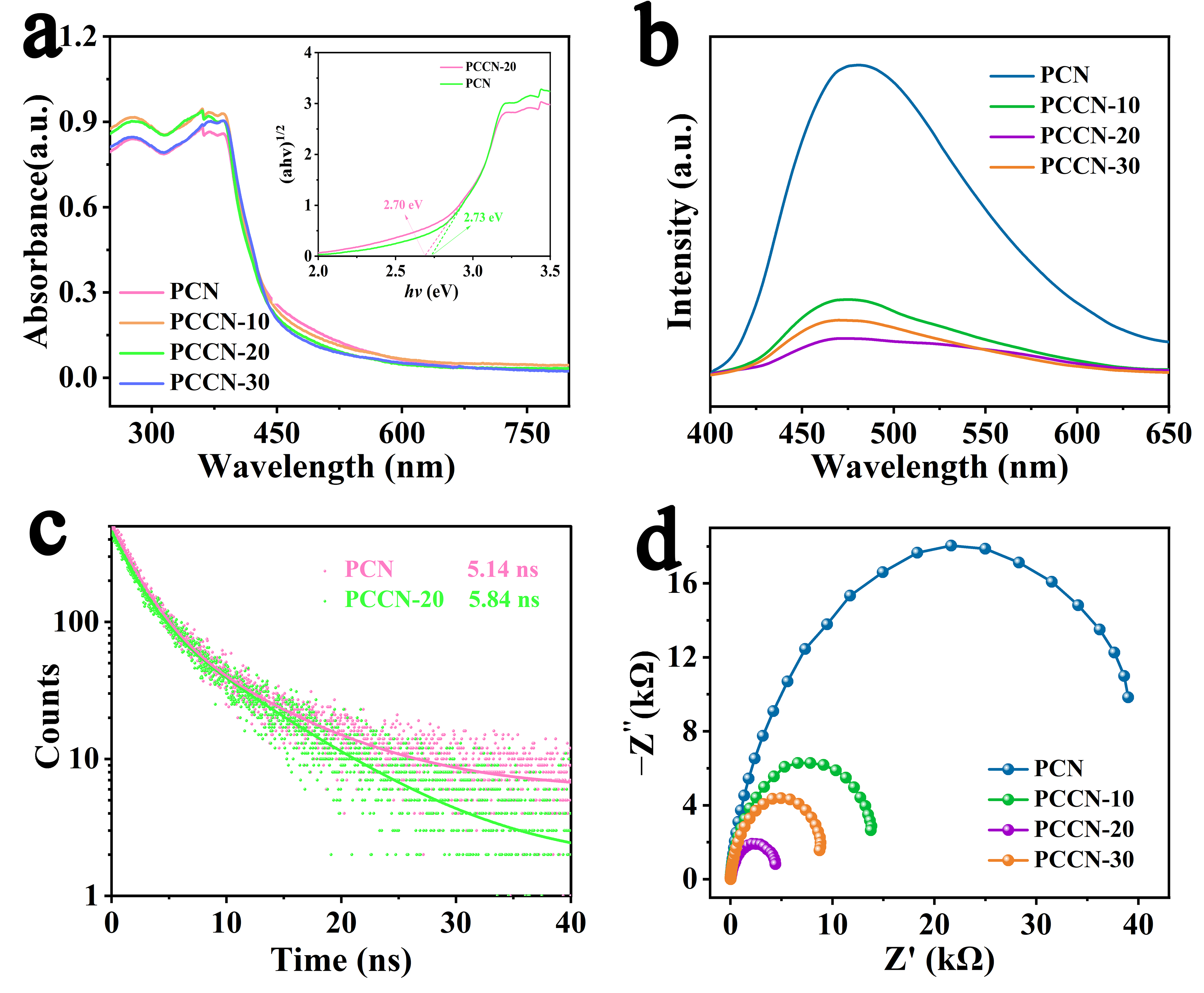
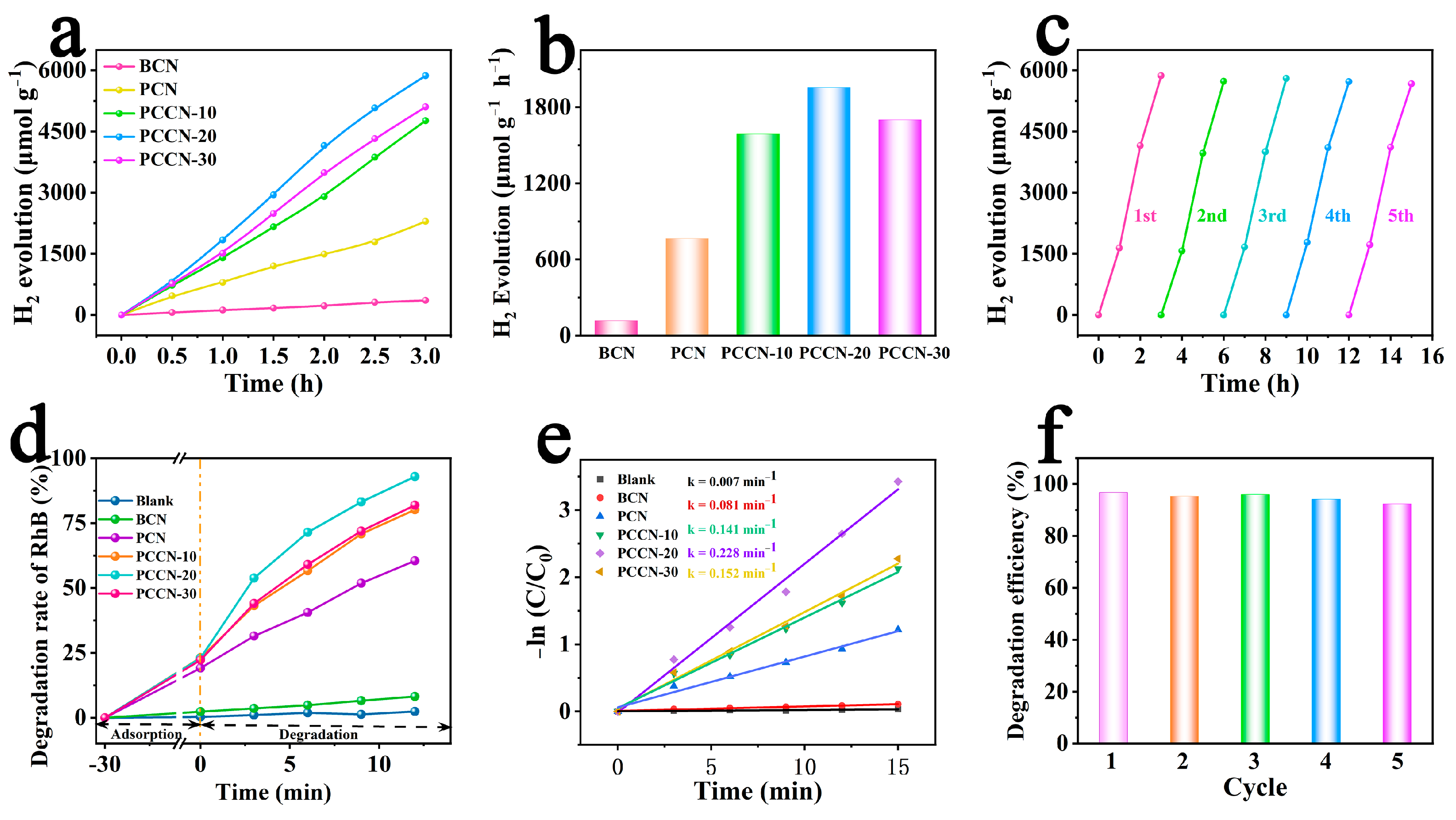
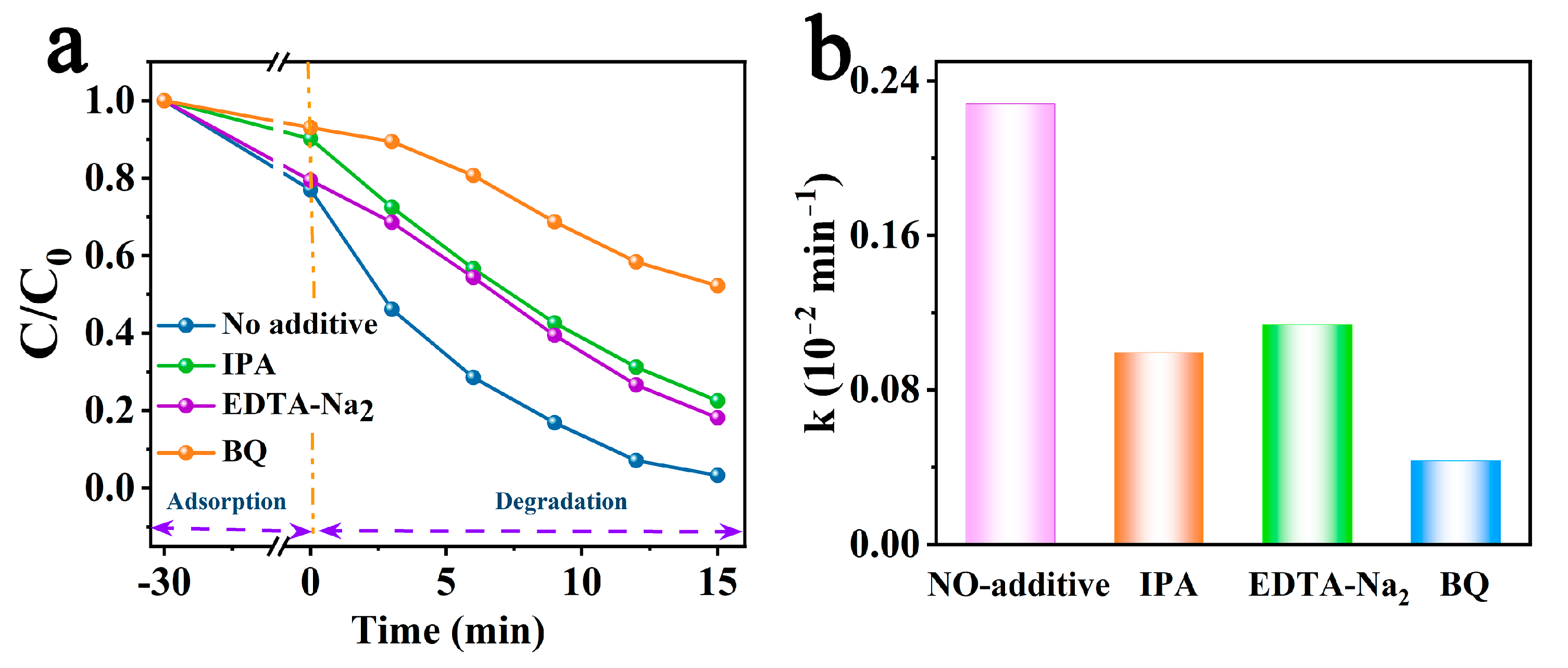

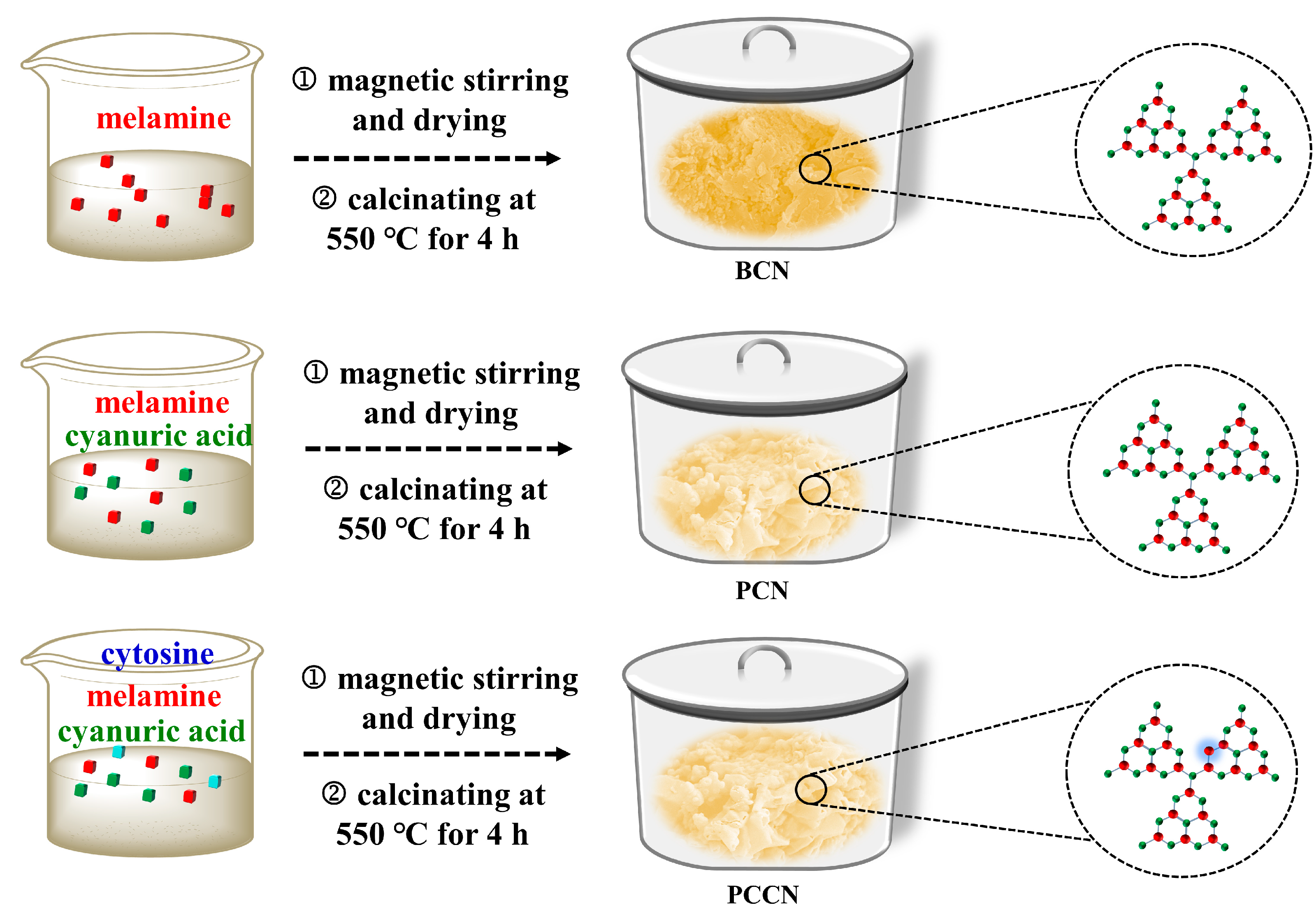
| Samples | Specific Surface Areas(m2 g−1) | Total Pore Volumes(cm3 g−1) |
|---|---|---|
| BCN | 15.16 | 0.153 |
| PCN | 69.25 | 0.506 |
| PCCN-10 | 75.08 | 0.560 |
| PCCN-20 | 85.68 | 0.562 |
| PCCN-30 | 76.68 | 0.518 |
| Atomic % | C | N | O |
|---|---|---|---|
| PCN | 47.39% | 50.67% | 1.93% |
| PCCN-20 | 48.19% | 49.72% | 2.09% |
| Samples | Decay Time (ns) | Relative Amplitude | Average Lifetime (ns) | ||
|---|---|---|---|---|---|
| τ1 | τ2 | A1 | A2 | ||
| PCN | 2.14 | 8.17 | 400.89 | 104.08 | 5.14 |
| PCCN-20 | 1.94 | 8.17 | 326.06 | 130.44 | 5.84 |
Disclaimer/Publisher’s Note: The statements, opinions and data contained in all publications are solely those of the individual author(s) and contributor(s) and not of MDPI and/or the editor(s). MDPI and/or the editor(s) disclaim responsibility for any injury to people or property resulting from any ideas, methods, instructions or products referred to in the content. |
© 2023 by the authors. Licensee MDPI, Basel, Switzerland. This article is an open access article distributed under the terms and conditions of the Creative Commons Attribution (CC BY) license (https://creativecommons.org/licenses/by/4.0/).
Share and Cite
Tian, C.; Li, C.; Zhao, C.; Liu, D.; He, X. A Novel Synthetic 3D Interconnected Porous Carbon-Rich Graphitic Carbon Nitride for Boosting Visible Light Photocatalytic Hydrogen Production and Dye Contaminant Degradation. Catalysts 2023, 13, 1345. https://doi.org/10.3390/catal13101345
Tian C, Li C, Zhao C, Liu D, He X. A Novel Synthetic 3D Interconnected Porous Carbon-Rich Graphitic Carbon Nitride for Boosting Visible Light Photocatalytic Hydrogen Production and Dye Contaminant Degradation. Catalysts. 2023; 13(10):1345. https://doi.org/10.3390/catal13101345
Chicago/Turabian StyleTian, Cunzhang, Chunling Li, Congyue Zhao, Dong Liu, and Xinping He. 2023. "A Novel Synthetic 3D Interconnected Porous Carbon-Rich Graphitic Carbon Nitride for Boosting Visible Light Photocatalytic Hydrogen Production and Dye Contaminant Degradation" Catalysts 13, no. 10: 1345. https://doi.org/10.3390/catal13101345
APA StyleTian, C., Li, C., Zhao, C., Liu, D., & He, X. (2023). A Novel Synthetic 3D Interconnected Porous Carbon-Rich Graphitic Carbon Nitride for Boosting Visible Light Photocatalytic Hydrogen Production and Dye Contaminant Degradation. Catalysts, 13(10), 1345. https://doi.org/10.3390/catal13101345






